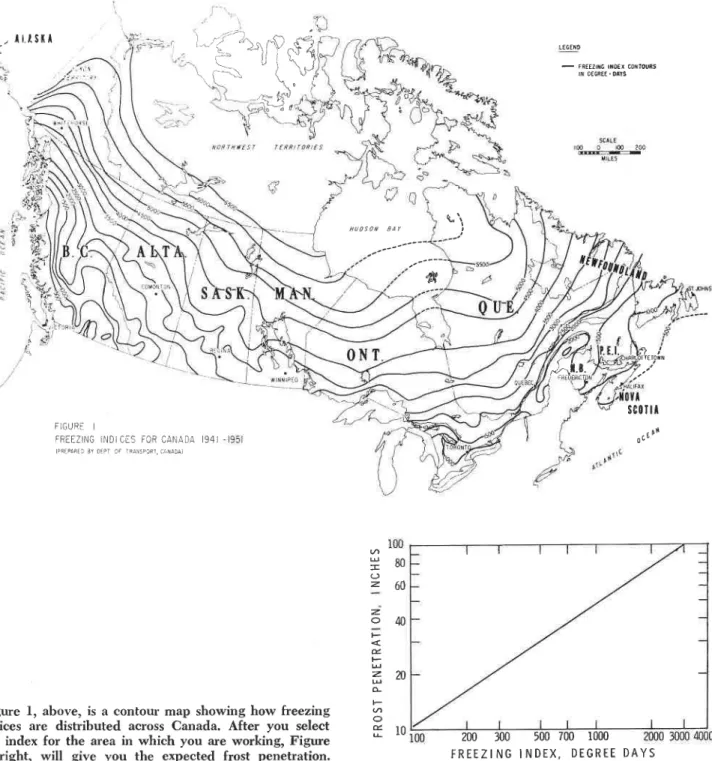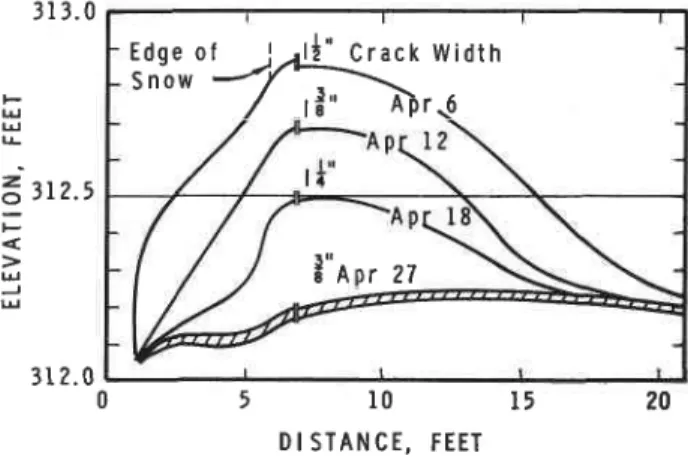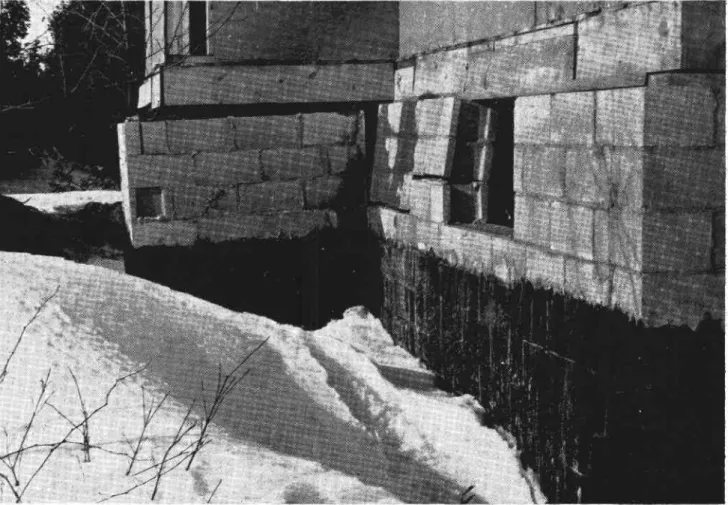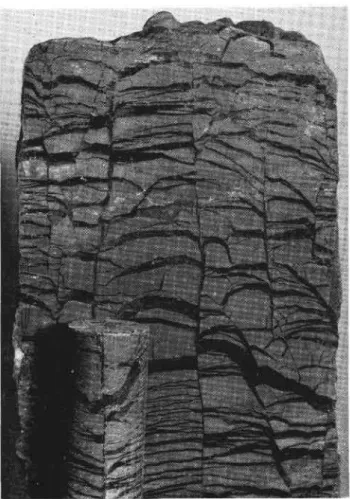Publisher’s version / Version de l'éditeur:
Engineering and Contract Record, 81, 1, pp. 51-57, 1968-02-01
READ THESE TERMS AND CONDITIONS CAREFULLY BEFORE USING THIS WEBSITE. https://nrc-publications.canada.ca/eng/copyright
Vous avez des questions? Nous pouvons vous aider. Pour communiquer directement avec un auteur, consultez la première page de la revue dans laquelle son article a été publié afin de trouver ses coordonnées. Si vous n’arrivez pas à les repérer, communiquez avec nous à PublicationsArchive-ArchivesPublications@nrc-cnrc.gc.ca.
Questions? Contact the NRC Publications Archive team at
PublicationsArchive-ArchivesPublications@nrc-cnrc.gc.ca. If you wish to email the authors directly, please see the first page of the publication for their contact information.
NRC Publications Archive
Archives des publications du CNRC
This publication could be one of several versions: author’s original, accepted manuscript or the publisher’s version. / La version de cette publication peut être l’une des suivantes : la version prépublication de l’auteur, la version acceptée du manuscrit ou la version de l’éditeur.
Access and use of this website and the material on it are subject to the Terms and Conditions set forth at
Frost action - construction hazard
Crawford, C. B.
https://publications-cnrc.canada.ca/fra/droits
L’accès à ce site Web et l’utilisation de son contenu sont assujettis aux conditions présentées dans le site
LISEZ CES CONDITIONS ATTENTIVEMENT AVANT D’UTILISER CE SITE WEB.
NRC Publications Record / Notice d'Archives des publications de CNRC:
https://nrc-publications.canada.ca/eng/view/object/?id=2db2b12e-dcda-4291-9994-bb6d763e95bd
https://publications-cnrc.canada.ca/fra/voir/objet/?id=2db2b12e-dcda-4291-9994-bb6d763e95bd
Ser
TE].
N2Lt2
no. 27O
e . 2
SLDe
NATIONAL RESEARCH COUNCIL OF CANADA
CONSEIL NATIONAL DE RECHERCHES DU CANADA
FROST
ACTION I
CONSTRUCTION
HAZARD
by
C. B. Crawford
AHA.H..Y,rii'j"i;
#ra"**
Reprinted from
Engineering
and Contract Record
Vol. Bl, No. 7, I,anuarg 1968
p . D r - D t
Technical Paper No. 270 of the
Division of Building Research
OTTAWA
February 1968
NRC 10016
Price l0 cents
L'ACTION DANGEREUSE DU GEL SUR LES OUVRAGES
SOMN{AIRE
Le gonflement du sol par le gel est un ph6nomdne habituel dans la plus grande partie du Canada, bien qu'on n'y pr6te gudre attention et que le mouvement du sol passe souvent inapergu. De temps en temps Ie gonflement du sol entraine d'importantes diff6rences de d6placement, qui causent des dommages aux ou-vrages. Il arrive que quelques-unes des difficult6s les plus graves ne soient pas pr6vues au bureau d:6tudes, mais qu'elles se concr6tisent pendant la construction i cause d'une protection insuffisante du sol d'assise contre le froid ou parce que la semelle des fondations a 6t6 plao6e sur un sol d6ji gel6. L'auteur pr6sente ici quelques dossiers de cas illustrant certaines difficult6s typiques qui auraient pu
This is typical damage that can be caused by frost action on a heavily travelled road. In this case. road is less than
two years old, so damage is the result of poor design. (This is Figure 6 referred to in the text of the article.)
Frosf
action-construction hazard
by CARL B. CRAWFORD
Frost heaving of the ground is common in most parts of Canada, although this is not generally appreciated because the movements are often un-noticed. Occasionally frost heaving causes serious differential movements and damage to strucfures. Sorne of the most serious frost action problems may not be anticipated in the structural design but may arise during construction, due to inadequate protec-tion ,of the subsoil from freezing or to the placing of footings on ground that is already frozen. Selected
Mr. Crawford is head of the SoiI Mechanics Section of NRC's Division of Building Research. In this paper, he describes examples that DBR has investi-gated of how ignorance of frost action can damage construction work and structures.
case records are presented here to illustrate t)rpical problems in construction that could easily have been avoided.
Temperatures in the gr'ound vary substantially throughout the year to a depth of about 20 ft. Below this depth the annual temperature variation will usually not exceed 2 degF. The annual temperature amplitude depends on the nature of the heat ex-change characteristics of the ground surface and on the thermal properties of the subsoil. Wet clay, for example, resists temperafure change more than damp sand.
In southern parts of Canada the mean annual ground temperature is 5 or 6 deg F warmer than the mean annual air temperature. Much of this difference can be attributed to the protection of the ground from extreme cold by seasonal snow cover. Snow cover is also very effective in reducing frost penetration. A useful rule-of-thumb is that each foo,t of undisfurbed snow cover reduces frost penetration
, , l t , l s I l
: \ e
'.5ll*,
ro (td
6tk-4 a
Figure l, above, is a contour map showing how freezing indices are distributed across Canada. After you select the index for the area in which you are working, Figure 2, right, will give you the expected frost penetration.
by about 2 ft and compacted snow reduces the penetration below the ground surface by an amount equal to its depth.
The major factors affecting the penetration of frost into the ground are the winter air temperatures, the surface cover characteristics, and the thermal properties of the soil. The severity of the winter air temperature can be reduced to a simple "Freezing Index." The F.I. is a summation of the degree-days below freezing (32 deg F) of the mean daily air temperature during the winter season. The average F.I. during a lO-year period (194f-1951) has been calculated by the Air Services Branch, Construction Division of the Canadian Department of Transport.
T E G E N D
- FnEE2r[G lfloEI CoNIOURS r x 0 E G R t E . 0 A t 5
w
')i,1,
sc
0I rt
. lll 0 L -200 300 500 700 1000 F R E E Z I N G I N D E X . D E G R E ED A Y SContours of F.I. for Canada, based on this work, are shown in Figure 1.
Elaborate formulae are available for computing frost penetration in the ground, but except for spe-cial cases they are of little use because the thermal properties of soil are so variable. For most purposes a satis-factory estimate can be made using. a widely accepted relationship between the Freezing Index and frost penetration shown in Figure 2. This re-lationship is a modification of the U.S. Corps of Engineers design curve as proposed by Dr. W. G. Brown of the Division of Building Research, Na-tional Research Council. It applies only to bare surfaces free of vegetation and snow cover.
\-\
llffi t IRLITTIIOSNry../
F I G U R E I F R E E Z I N G I N D I C E S F C R C A N A D A I 9 4 I ( F R E P A i T ! A Y O E P T O F I R A I S P ' R I , C I N I D A ) u n n -z. 60 z. w F ts r z ? n i l lWhen surface
is level
but subsurface
varies,
d ifferentia
I frost action
can cause severe
heaving
The mechanism of frost action is now reasonably well understood. It is known that when the frost penetrates fine-grained soils from the surface, water is drawn up from the unfrozen soils below, causing layers of ice to form. The growth of these 'ice lenses" creates a large increase in the volume of the soil and causes the surface to heave. During the spring the upper soils thaw and release large quan-tities of water which, if not drained rapidly, result in a serious loss ,of strength in the soil. This action causes the deterioration of roads and streets during "spring breakup." Frost action can be prevented by replacing the fine-grained soils with coarse, well-drained material or by protecting the ground fiom
freezing.
Damage fo pavemenf
Frost heaving shows up on roads or streets when there is a discontinuity in the subsurface conditions. Figure 3 shows pavement heave adjacent to a stationary manhole. The problem can be reduced by deepening the base course around the manhole so that vertical movements do not change abruptly. Limited success has been achieved try fastening the manhole rim firmly to the pavement and allowing it to move vertically through a slip joint to the manhole wall.
Figure 4 shows a longitudinal crack in a pave-ment surface due to unequal frost penetration. This was caused by clearing the snow from the centre of the road and piling it at the edges. The magrritude of the heave and the size of the crack at the end of the winter are shown in Figure 5. Note that the surface has heaved approximately B in. where the snow cover has been removed, but little heave has occurred near the edges where snow has been piled. By the end of April the surface has returned to its original elevation. The frost heaving at this location is greater than normal for the area, probably because it is near the bottom of a slope where the ground water table is close to the surfice.
In the roadway described above, ground move-ment gauges were installed at depths of l, 2, and 3
Figure 3. Manhole remained stationary but pavement heaved around it because of discontinuity underground.
Figure 4. Snow was cleared from centre of this road and stacked on edge. Unequal frost penetration caused crack.
3 1 3 . 0
3 I 2 . 0
0 5 1 0 1 5 2 0
D I S T A N C E , F E E T
Figure 5. This is a measure of the heaving caused at various points by frost in the road shown in Figure 4. ft. The upper foot of the cross-section, composed of non-frost-susceptible materials, did not heave. The frost penetrated less than 3 ft so that all the frost heave occurred in the natural clay subgrade between depths of t and 3 ft. Heaving of the l-ft gauge began about I December and by the end of December it had heaved 4 in. A further 3 in. of heave occurred during January and February. Very small movements occurred during March and the ground returned to normal by the end of April. At the 2-ft depth heaving began early in ]anuary and reached a maximum of nearly 2lz in. by the end of February.
The final distortion of the pavement surface shown in Figure 5 is much less than it would have been under heavy traffic conditions. Figure 6 shows the more usual dete.ri,oration of a heavily travelled road during the spring thaw. The pavement in this case was less than 2 years old and the failure is therefore the result of inadequate design.
F r U r = ? 1 ' I o J L L . .
;
U J riiX'','7ffi,:;"'
8 " l p r
z z
z 4 0 0 6 6 0 0 E a o o ; 1 0 0 0 o o 1 2 0 0
Figure 7. This pavement heaved around drainpipe that crosses under road. The pipe trench itself did not move.
Figure 9. When an unheated stuucture is fastened rigidly to heated one, shown above, frost often causes distortions.
Figure 10. The cracks in the brick wall were caused by difierential heaving of ground under unheated garage.
Figure 7 shows a discontinuity due to non-frost-susceptible backffll of a drainage pipe through a road on frost-susceptible soil. Measurements revealed almost no heave over the pipe and up to 4 in. of heave in the adjacent roadway. This problem was solved by installing rigid insulation ,over the sub-grade adjacent to the pipe. The condition could also have been corrected by providing a wedge of non-frost-susceptible backffll on either side of the pipe.
Careful observations of the movement of a de-tached unheated garage were rnade regularly for 4 years. During the worst of the four winters there were more than 1600 degree-days below 32 deg F. This is shown in Figure 8 and may be compared
T IM E
Figure 8. These two charts show the relationship between heave (above) and the severity of the climate (below).
with the magnitude and rates of heaving during fteezing and settlement as the ground thawed. The garage was resting on a 5-in. concrete slab over a 6-in. sand cushion on natural clay.
A few observations on a horizontal section of the driveway near the garage showed that it heaved about the same amount as the ,garage, but near the bottom of a 3-ft slope to the street the maximum heave was 6-in. The greater heave at the bottorn of the slope is attributed to the proximity of the water table, Despite these substantial movements the garage and driveway have performed satisfactorily.
Differential heaving is most obvious, and damaging, when an unheated structure is attached to a heated building. Figure g illustrates a common failure of this type. The situation has been aggravated by the rigidity of the roof design. In this case the garage is founded on the surface of the ground, but the problem is not necessarily solved by constructing a deep foundation. Figure l0 shows a case where the garage footings were placed at the same depth as the house footings but because the garage was unheated the frost penetrated on both sides of the foundation wall. The heaving ground therefore gripped and heaved the foundation wall, causing unsightly cracks in the front and rear brick walls and preventing satisfactory operation of the overhead door.
One of the most common situations where heaving occurs owing to adhesion of frozen ground is at the steps Ieading into houses. Although the footings are well below the frost line, the area under the steps is often not heated and the snow iS cleared away from the approaching sidewalk. The frost therefore penetrates deeper than it does next to the main
t 4 0 0 1 6 0 0 I 8 0 0 A P R M A R N O V DEC FEB
foundation wall and the lightly loaded step offers little resistance to heaving.
Figure II(a) shows a cross-section of a concrete
step Ieading in'to a housd. The subsoil is the same as that under the detached garage shown in Figure 8. In this case the frost penetrated about 2 ft under the sidewalk, causing the front of the concrete block foundation wall to heave and crack horizontally, and the sidewalls to cr.ack diagonally. A maximum ver-tical movernent of aboat Vz in. occurred every yeat, and althou'gh the wall settled back in the spring-tirne it lef't a source of leakage. As shown in Figure
ll(a) the solution was to dig away the clay and
backffll a wedge of crushed stone which was drained into the house tile. A few inches of clay were left at the top as a seal against surlace water. It has since performed satisfactorily for several years.
At 'the rear of the same house a screened patio was built on ,a concrete slab. To prevent heaving, the perimeter stone wall of ,the patio was founded on 2 ft of crushed stone placed in a trench as shown in Figure 11(b). The slab was placed on 12 in. to 18 in. of crushed stone and the trench was connected to the house tile for drainage. Temperatures under the slab were observed with thermocouples during four winters and the deepest penetration of frost is shown in Figure 11(b). The ra,ther shallow pene-tration of the frost line is due to heat loss from the house and to snow cover around the pafio. No measurable heave of the patio has occurred in the 7 years since construction. The trenching method ap-pears to be more satisfactory than deep footings in cases where frost is able to penetrate beside the foundation wall.
A particularly serious case of frost heaving was observed art a small cottage resting on concrete block footings. The surface of the silty-clay subsoil, located only 7 ft above the adjacent rriver level, provided ideal conditions for frost heaving. The owner wished to winterize the cot age and. at the same time to reduce the annual distortion due to differential heaving. He was advised to replace the surface foot-ings with pipes eltending below the frost line (3 to 4 ft) and set into concrete. In principle the concrete was to anchor the pipe against heave and the pipe was to provide a minimum of surface area for adhesion to the,frozen soil.
Four-inch diameter pipes were installed as shown in Figure 12 to a depth of approximately 3% ft but, because of ground water conditions in the silty soil, it was not possible to place corrcrete in the bottom of the holes and the pipes were rested on concrete slabs. During the firsrt winter differential heaving was much worse than normal ibut investigation re-vealed ,that the three interior footings had not been replaced. These three footings heaved so much that the entire stmcture was raised and -sornel,of,. the perimeter pipes had been lifted free of their con-crete slab footings. Figure 13 shows the d,istortion in one of the beams under the cottage. Normal ground heaving around the cottage is about 8 in.
althouglr the maximum differential heave of the
building was not measured. During excavation
r . r S c a l e i n l e e t { b l 0 5
Figwe ll. Outside stairways (left) and light structures like patios (right) are vulnerable to damage from frost.
Figure 12. Pipes supported by concrete footing below frost line replace former surface footings on this building.
Figure 13. Before foundations were changed (Figure l2), difterential heaving caused this distortion in, foor beams.
around the pipes the maximum observed frost depth was 34 in.
The following summer the,interior footings were replaced by pipes on pads and the performance of the building has been satisfactory since that time.
Some of the worst damage due to frost heaving
M a x . f l o s t / p e n e t r a l i o n
Figure 14. Severe damage when the construction was
resulted to this foundation stopped during the winter.
Since the basement was unheated, frost penetrated under the footings and destroyed the foundation walls (above).
occurred at the centre of the footing under the steel forms which had apparently acted as fins through the insulation to extract heat from the subgrade. The solution of the problem was to drape the walls with canvas and apply heat beneath the covers. This caused the footings to settle back to their original levels and construcLion proceeded satisfactorily.
Structural distortions
Frost heaving during construction is much more serious when the structure is at an advanced stage, because distortions may be built in. Such a building on spread footings was studied during construction when evidence of frost heaving becarne apparent. Interior partitions were crushed between the heaving ground-level foors and the reinforced concrete struc-ture, and serious cracks occurred adiacent to deep exterior footings which were unaffected by the frost
penetration. Unknown load transfers occurred
throu$rdut'as the structural frame was being dis-torted ( Figure 16 ). After artiffcial thawing many walls and floors had to be rebuilt and the stresses caused by the distortion remain unknown.
occurs during construction, often when it is least expected. A striking example, given in Figure 14, is a house under construction which had been left unattended during winter. Had the building been finished and occupied, there would have been little risk of serious damage by frost, but because the basement was unheated frost penetrated beneath the footings and destroyed the foundation walls.
Frosf hits large lobs
Damage of this nature is not limited to small construction jobs. A similar case involved the winter-time construction of a 4-storey addition to a large building. The perimeter and interior footings had been cast and steel wall-forms were in place ready for concreting when cold weather caused a tem-porary halt in construction. The area was covered with straw insulation, but when work resumed the forms were found to be 2 in. too high where they joined the existing building. Investigfation revealed that the entire strip footing, which was 7 ft wide, had been heaved approximately 2 in. above the sub-grade, as shol,rryr in Figure 15. The heaving had
In another case a major structure, 7 storeys high and costing $3 million, was being built during winter when movement was observed botween the build-ing and a tunnel leadbuild-ing to it. Investigation revealed that the entire structure, which was then built to its full heighrt, had heaved approximately 2 to 3 in. The building was founded on clay at a depth of 7 ft with only a shallow crawl space between the ground foor and a l5-in. reinforced concrete mat. During a particularly cold period the temperature in the crawl space dropped well below freezing and frost penetrated the corr-crete mat and 8 in. into the clay subsoil. Figure 17 shows the ice lenses in a sample of clay obtained by boring through the foundation.
The heaving of this large building caused great concern at the time. It hardly seemed possible that such a large building could have been lifted by frost, but the unit bearing pressure on the founda-tion mat was not large. Fortunately, the heaving was relatively uniform and it was possible to apply heat to the crawl space and to lower the building to its original elevation in about 3 weeks. No serious afterefiects were apparent.
!-rost heaving is a common occunence in cold regions. In many cases prevention is not worth the expense, but often it creates costly maintenance problems and sometimes it causes untold worry to desi;ners and builders alike. The case records desL ribed are representative of a widespread design and construction problem in Canada.
What causes
frost damage?
To cope with the problem it is necessary to rec-ognize that ffne-grained soils are subjeot to significant frost heaving, that the ready avaitrability of ground water magnifies the heaving, and that snow cover and the heat transmitted from buildines have a marked influence on ground temperatures. If founda-tion loads are great enough they will resist, or even prevent frost heaving, but it is dimcult to assess the load required for this. It is better to prevent the soil from freezing by heating or insulation tech-niques, or to isolate the structure from heaving ground by a layer of well-drained crushed stone or clean gravel. Well-drained rock-fflled trenches ap-pear to provide a better foundation than blo'ck walls on footings where the ground freezes around the wall. For light unheateditructures, such as cottages and car ports, a series of vertioal pipes of small diameter resting in concrete below the frost line appear to provide an economical and satisfactory foundation design. In these situations rigid insula-tion may be applied to reduce or prevent freezing of the ground.
Beware frost during construction
Most important is the need to consider potential frost heave problems during construction. This should be in the minds of builders and inspectors during all phases of winter construction.
Figure 15. Spade demonstrates 2-in. gap that was created under 4-storey building by frost during the construction.
Figure 16. Frost is more dangerous when building is advanced because distortions (above) could be built in.
Figure 17. Ice lenses seven-storey building
sample of clay heaved a from its original level. in this





